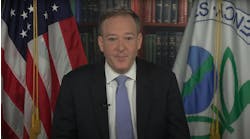As Australia’s climate continues to play havoc with its inhabitants, one of the country’s top atmospheric scientists is pointing the finger of blame at aerosols.
These fine particle suspensions may have a far greater impact on the country’s rainfall and future climate change than previously thought, believes Leon Rotstayn of the Commonwealth, Scientific and Industrial Research Organisation (CSIRO), Clayton, Australia. Speaking at the International Conference on Southern Hemisphere Meteorology and Oceanography in Melbourne on Feb. 18, Rotstayn said, “We have identified that the extensive pollution haze emanating from Asia may be re-shaping rainfall patterns in northern Australia but we wonder what impact natural and human-generated aerosols are having across the rest of the country.”
Sources of human-generated aerosols include industry, motor vehicles and vegetation burning. Natural sources include volcanoes, dust storms and ocean plankton. Human-generated aerosols have long been known to exert a cooling effect on climate. This has partly masked the warming effect of increasing levels of greenhouse gases. As aerosol pollution is predicted to decrease over the next few decades, unmasking the greenhouse effect may lead to accelerated global warming.
Potentially more troubling is Rotstayn’s belief that aerosols can actively force changes in winds and ocean currents by altering distribution of solar heating at the earth's surface.
However, new simulations with the CSIRO climate model show big improvements in El Niño simulation and associated natural rainfall variability over eastern Australia, when natural and human-generated aerosols are included in the model.
“Natural aerosol includes Australian dust, which may be the key factor that improved our simulation. A realistic simulation of natural rainfall variability is essential if a climate model is to be used to improve our understanding of Australian rainfall changes.”
Rotstayn stressed that further research into how aerosols are influencing climate and rainfall patterns across Australia is critical to scientists’ abilities to more accurately predict longer-term effects of climate change. Meanwhile, the mysteries of atmospheric modelling are keeping scientists at the University of Michigan, Ann Arbor, Mich., busy, too.
Current travel logs of greenhouse gases are based on atmospheric sampling locations sprinkled over the earth and short towers that measure uptake or carbon release from a small patch of forest. The challenge for the scientists is that those measurements don’t agree with current computer models of how plants and soils behave.
Now Anna Michalak, assistant professor in the Department of Civil and Environmental Engineering and the Department of Atmospheric, Oceanic and Space Sciences, has developed a solution: “Geostatistical inverse modelling” breaks the globe into small regions and examines how much carbon must have been emitted in each region to achieve the concentrations measured at atmospheric sample points.
This allows Michalak and her collaborators to use information from satellites that measure the earth’s surface to supplement information from the atmospheric monitoring network. Eventually, it aims to trace carbon levels at each sample point to a particular source or sink.
“Winds and weather patterns mix carbon dioxide in the atmosphere just like stirring mixes cream in a cup of coffee. As soon as you start stirring, you lose some information about where and when the cream was originally added to the cup. With careful measurements and models, however, much of this information can be recovered. One of our big questions is how carbon sources and sinks evolve – this is all with an eye on prediction and management,” she says.
Even as models improve, however, there still might not be time to do anything about climate change. The world economic crisis has hit investment in clean energy. Its growth is no longer on track for the world to avert climate change’s worst impact, according to New Energy Finance (NEF), High Holborn, London, clean energy and carbon market analysts.
Presenting its Global Futures 2009 insights to the second New Energy Finance Summit on March 4, NEF analysts say that although lower economic activity due to the financial crisis will reduce carbon dioxide emissions, in the longer term drying up of funding for lower-carbon energy solutions is likely to have far greater adverse impact on emissions.
Some experts fear that continued emissions growth beyond 2015, or 2020 at the latest, would create the strongest risks of severe and irreversible climate change. NEF analysis shows that a peak much before 2020 currently looks highly unlikely.
“This should be a real wake-up call,” said Michael Liebreich, NEF chairman and CEO. “New Energy Finance is generally on the optimistic side of the debate: even with the current recession we are more bullish on the shift to clean energy than most mainstream analysts. However, it is no longer possible to say we are on track to achieve peak carbon dioxide by 2020.”
Seán Ottewell is Chemical Processing's Editor at Large. You can e-mail him at [email protected].

